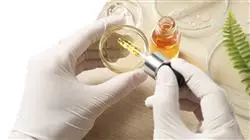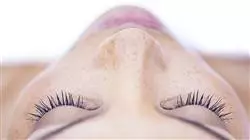University certificate
The world's largest faculty of pharmacy”
Introduction to the Program
Explore the most prominent developments in facial and body care products, examining active ingredients and modern cosmetic forms from the hand of professionals specialized in the area”

Investment in innovation is high in the cosmetic and perfume sector, which makes R&D&I departments in the industry the true catalysts of discoveries in specialties as diverse as the study of the skin, preparing formulations or various skin alterations. Therefore, the program offers pharmacists with an interest in this field a wide range of scientific postulates and research of all kinds.
Whether it is in R&D&I laboratories, industrial manufacturing processes, regulatory affairs departments or consulting pharmacies and cosmetic centers, the level of up-to-date knowledge professionals have definitely plays a vital role in carrying out their work based on the most rigorous scientific practice.
Consequently, our academic program has been developed by a team of highly qualified professionals to cover all the most relevant areas of Cosmetic Science and Technology. Researchers, R&D&I managers, analysts and marketing managers have developed a syllabus that covers everything from skin analysis and relevant skin alterations in cosmetics to quality control, product development and marketing specific to the sector.
The program will follow TECH pedagogical methodology, which exempts students from the constraints of a traditional academic calendar. All the content on this Professional Master's Degree is available in the virtual classroom, and can be downloaded and studied at any time from the comfort of the tablet, computer or smartphone of choice.
The content is reinforced by a multitude of real cases and practical examples, which provide pharmacists with the necessary contextualization of currently specific issues such as natural cosmetics and nutricosmetics. By the end of the course, students will have acquired a broad and updated vision of all Cosmetic Science and Technology, having thoroughly studied the most important competencies for daily professional practice.
Delve into a multitude of topics surrounding Cosmetic Science and Technology, including nanotechnology in cosmetics, perfumes and new trends in cosmetic marketing”
This Professional master’s degree in Cosmetic Science and Technology contains the most complete and up-to-date scientific program on the market. The most important features include:
- Practical cases presented by experts in Cosmetic Science and Technology
- The graphic, schematic, and practical contents with which they are created, provide scientific and practical information on the disciplines that are essential for professional practice
- Practical exercises where self-assessment can be used to improve learning
- Its special emphasis on innovative methodologies
- Theoretical lessons, questions to the expert, debate forums on controversial topics, and individual reflection assignments
- Content that is accessible from any fixed or portable device with an Internet connection
Get up to date with the main novelties in skin permeability, pigmentary alterations, skin aging and natural and synthetic active ingredients”
The program’s teaching staff includes professionals from the sector who contribute their work experience to this program, as well as renowned specialists from leading societies and prestigious universities.
The multimedia content, developed with the latest educational technology, will provide the professional with situated and contextual learning, i.e., a simulated environment that will provide immersive specialization programmed to learn in real situations.
This program is designed around Problem-Based Learning, whereby the professional must try to solve the different professional practice situations that arise throughout the program. For this purpose, the student will be assisted by an innovative interactive video system created by renowned and experienced experts.
Download all the content available in the virtual classroom: You decide when, where and how to take on the entire course load”

The large number of self-knowledge exercises and complementary readings for each topic available will help you expand your knowledge in cosmetic areas of great interest to you”
Why study at TECH?
TECH is the world’s largest online university. With an impressive catalog of more than 14,000 university programs available in 11 languages, it is positioned as a leader in employability, with a 99% job placement rate. In addition, it relies on an enormous faculty of more than 6,000 professors of the highest international renown.

Study at the world's largest online university and guarantee your professional success. The future starts at TECH”
The world’s best online university according to FORBES
The prestigious Forbes magazine, specialized in business and finance, has highlighted TECH as “the world's best online university” This is what they have recently stated in an article in their digital edition in which they echo the success story of this institution, “thanks to the academic offer it provides, the selection of its teaching staff, and an innovative learning method aimed at educating the professionals of the future”
A revolutionary study method, a cutting-edge faculty and a practical focus: the key to TECH's success.
The most complete study plans on the university scene
TECH offers the most complete study plans on the university scene, with syllabuses that cover fundamental concepts and, at the same time, the main scientific advances in their specific scientific areas. In addition, these programs are continuously being updated to guarantee students the academic vanguard and the most in-demand professional skills. In this way, the university's qualifications provide its graduates with a significant advantage to propel their careers to success.
TECH offers the most comprehensive and intensive study plans on the current university scene.
A world-class teaching staff
TECH's teaching staff is made up of more than 6,000 professors with the highest international recognition. Professors, researchers and top executives of multinational companies, including Isaiah Covington, performance coach of the Boston Celtics; Magda Romanska, principal investigator at Harvard MetaLAB; Ignacio Wistumba, chairman of the department of translational molecular pathology at MD Anderson Cancer Center; and D.W. Pine, creative director of TIME magazine, among others.
Internationally renowned experts, specialized in different branches of Health, Technology, Communication and Business, form part of the TECH faculty.
A unique learning method
TECH is the first university to use Relearning in all its programs. It is the best online learning methodology, accredited with international teaching quality certifications, provided by prestigious educational agencies. In addition, this disruptive educational model is complemented with the “Case Method”, thereby setting up a unique online teaching strategy. Innovative teaching resources are also implemented, including detailed videos, infographics and interactive summaries.
TECH combines Relearning and the Case Method in all its university programs to guarantee excellent theoretical and practical learning, studying whenever and wherever you want.
The world's largest online university
TECH is the world’s largest online university. We are the largest educational institution, with the best and widest online educational catalog, one hundred percent online and covering the vast majority of areas of knowledge. We offer a large selection of our own degrees and accredited online undergraduate and postgraduate degrees. In total, more than 14,000 university degrees, in eleven different languages, make us the largest educational largest in the world.
TECH has the world's most extensive catalog of academic and official programs, available in more than 11 languages.
Google Premier Partner
The American technology giant has awarded TECH the Google Google Premier Partner badge. This award, which is only available to 3% of the world's companies, highlights the efficient, flexible and tailored experience that this university provides to students. The recognition as a Google Premier Partner not only accredits the maximum rigor, performance and investment in TECH's digital infrastructures, but also places this university as one of the world's leading technology companies.
Google has positioned TECH in the top 3% of the world's most important technology companies by awarding it its Google Premier Partner badge.
The official online university of the NBA
TECH is the official online university of the NBA. Thanks to our agreement with the biggest league in basketball, we offer our students exclusive university programs, as well as a wide variety of educational resources focused on the business of the league and other areas of the sports industry. Each program is made up of a uniquely designed syllabus and features exceptional guest hosts: professionals with a distinguished sports background who will offer their expertise on the most relevant topics.
TECH has been selected by the NBA, the world's top basketball league, as its official online university.
The top-rated university by its students
Students have positioned TECH as the world's top-rated university on the main review websites, with a highest rating of 4.9 out of 5, obtained from more than 1,000 reviews. These results consolidate TECH as the benchmark university institution at an international level, reflecting the excellence and positive impact of its educational model.” reflecting the excellence and positive impact of its educational model.”
TECH is the world’s top-rated university by its students.
Leaders in employability
TECH has managed to become the leading university in employability. 99% of its students obtain jobs in the academic field they have studied, within one year of completing any of the university's programs. A similar number achieve immediate career enhancement. All this thanks to a study methodology that bases its effectiveness on the acquisition of practical skills, which are absolutely necessary for professional development.
99% of TECH graduates find a job within a year of completing their studies.
Professional Master's Degree in Cosmetic Science and Technology.
In today's world, beauty and personal care are important aspects of everyday life. The cosmetics sector has experienced unprecedented growth in recent years, which has driven the demand for highly trained professionals in the field of cosmetic science and technology. TECH Global University offers you the opportunity to gain specialized knowledge with our Professional Master's Degree in Cosmetic Science and Technology. This graduate program aims to provide comprehensive and up-to-date training in cosmetic product research and development. Throughout the Professional Master's Degree, you will be immersed in the fundamental principles of chemistry, biology and technology as applied to cosmetic development. In addition, they will learn to identify market needs and current trends to design and create innovative and high quality products.
Become an expert in cosmetic product development and innovation.
The program also includes in-depth training in project management, marketing, regulatory and legal aspects of the cosmetics industry, enabling students to be prepared to lead research and development projects and work in leading companies in the beauty industry. Our teaching team is made up of experts in the field of cosmetic science and technology, ensuring that our students acquire the knowledge and skills necessary to succeed in the job market. Take advantage of this opportunity to become a Postgraduate Diploma in cosmetic science and technology and stand out in a constantly evolving industry!







